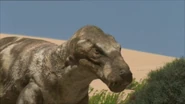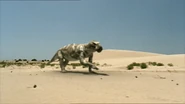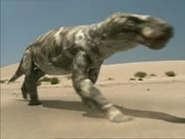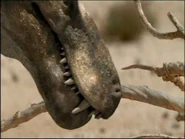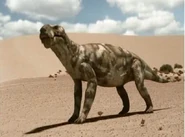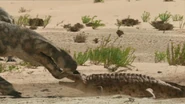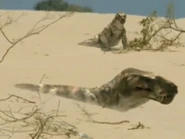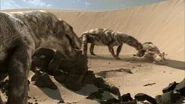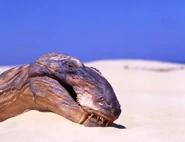| “ | His attacker is a carnivorous Gorgonopsid. She's fast, powerful and equipped with deadly weapons no hunter has had before. | ” |
– Kenneth Branagh when a female Gorgonopsid attacks a Scutosaurus. | ||
Gorgonops was a gorgonopsid, a type of a stem-mammal that flourished during the Permian, but died out before the Mesozoic, as it became extinct during the Permian-Triassic extinction event, also known as the Great Dying, which caused the extinction of about 53% of biological families, 84% percent of biological genera, 70% of land species and 95% of marine species.
Creature Attributes[]
Physical appearance and biology[]
Though it wasn't their direct ancestor, Gorgonops was already broadly similar to modern mammals, at least on the outside. It had several types of teeth in its jaws and legs that were located directly beneath its body, rather than in a sprawling posture (unlike Dimetrodon). It didn't have a sail and possibly could have regulated its body temperature internally. It doesn't have fur and it still laid eggs, though it isn't known for sure whether or not it took care of its young, unlike the true mammals or other mammal-like reptiles (i.e. Thrinaxodon).
One of the most characteristic traits of Gorgonops and other gorgonopsids were its sabre teeth - the first sabre teeth on the planet. Unlike the jaws of the later sabretooths, such as Smilodon from the Pliocene, the jaws of Gorgonops were relatively long, but they had only two types of teeth - the killing sabre-like canines and the shorter incisors. Together, these teeth and jaws made effective killing weapons, but were useless at chewing meat, and the gorgonopsids probably fed in a manner similar to modern Komodo dragons or crocodilians - they ripped away chunks of flesh and swallowed them whole. This method of eating was rather inefficient and may have been one of the reasons as why the gorgonopsians have died out.
Behavior and traits[]
Despite its size, Gorgonops was an ambush predator, lurking behind natural cover, before ambushing its prey, Dicynodonts like Lystrosaurus and Pareiasaurs like Scutosaurus. It would chase and catch up to them, before inflicting wounds with its' sabre-like teeth, causing the herbivores to die from blood loss and pain shock - and then it would eat.
Though it looked like a mammal, Gorgonops didn't have a social life as modern mammals do. Still, it could tolerate other members of its kind, just like the modern crocodiles, and the members of this species would gather in groups at watering holes and similar places, at least for a time.
In Walking with Monsters[]
Reptile's Beginnings[]
At the end of the episode, a Dimetrodon evolves into a Gorgonops.
Clash of Titans[]
The first half of the episode, taking place during the late Permian, is focused primarily on the Gorgonops. The episode demonstrates that this mammal-like reptile already has some mammalian traits that are more advanced than in case of Dimetrodon: more heterogenous teeth (including the first saber-like canines in the history of the planet), mammal-like posture and the beginnings of social interaction between the members of this species.
This episode also depicts the Gorgonops hunting other animals of the Permian period - Scutosaurus, Rhinesuchus and Diictodon. Regardless of being the top predator of its age, the Gorgonops still goes extinct during the Permian-Triassic extinction event, without leaving any direct descendants.
Behind the scenes[]
Gorgonops was never named in Walking with Monsters, but called 'a gorgonopsid' instead. Its' name was revealed in The Complete Guide to Prehistoric Life.
Gorgonops never encountered Scutosaurus in real life, because the latter lived in Russia - not in Africa, where Gorgonops lived. Gorgonops did hunt other pareiasaurs, like Pareiasaurus, though. But the gorgonopsid was more likely an Inostrancevia since it lived at the same time and place as Scutosaurus and the Siberian species of Diictodon.
Gorgonopsids are thought that to have had fur rather than scales or leathery skin.
Gallery[]
List of appearances[]
Notes and references[]

